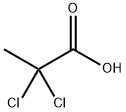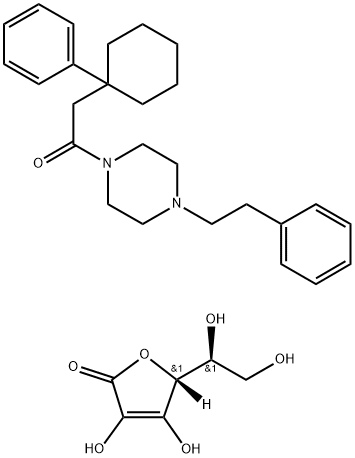Dalapon , 90% , 75-99-0
Synonym(s):
2,2-Dichloropropionic acid;Dalapon
CAS NO.:75-99-0
Empirical Formula: C3H4Cl2O2
Molecular Weight: 142.97
MDL number: MFCD00004178
EINECS: 200-923-0
| Pack Size | Price | Stock | Quantity |
| 1G | RMB719.20 | In Stock |
|
| 5G | RMB3495.20 | In Stock |
|
| others | Enquire |
PRODUCT Properties
| Melting point: | 166°C (dec.) |
| Boiling point: | 202°C |
| Density | 1.4014 |
| refractive index | 1.4544 |
| Flash point: | >110°C |
| storage temp. | 0-6°C |
| solubility | Acetonitrile (Slightly), Chloroform (Sparingly), Methanol (Slightly) |
| pka | pK1:2.06 (25°C) |
| form | Liquid |
| color | Colorless to Light yellow |
| Water Solubility | 50.2 g/100 mL |
| Sensitive | Moisture Sensitive |
| Merck | 14,2802 |
| BRN | 1750149 |
| Stability: | Hygroscopic |
| CAS DataBase Reference | 75-99-0(CAS DataBase Reference) |
| NIST Chemistry Reference | Propanoic acid, 2,2-dichloro-(75-99-0) |
| EPA Substance Registry System | Dalapon (75-99-0) |
Description and Uses
Dalapon is a commonly used herbicide for the control of annual and perennial grasses in croplands. The US Environmental Protection Agency (EPA) has listed dalapon as a general use pesticide and categorized dalapon as a Class II toxic agent (moderately toxic). As such, any product that contains dalapon would be labeled with ‘warning.’ The moderate toxicity associated with dalapon is confined primarily to workers around dalapon and those individuals who are applying dalapon. Contact with the herbicide can be caustic to human skin, damaging to the conjunctiva of the human eye, and irritating/damaging to the upper respiratory system of humans. When used to control grasses in cropland as well as noncropland, dalapon is distributed via either aerial or ground equipment for foliage application. Some of the common croplands that have benefitted from dalapon application include corn, potatoes, legume crops, citrus, fruit, and nut trees. It is used extensively in the western United States to control a variety of grasses such as Bermuda, Johnson, Crab, and Quack grasses. Dalapon is translocated to the roots where it acts as a growth regulator. Although highly soluble with the ability to readily move through the environment, dalapon is relative safe and instances of dalapon intoxication are rare. The primary sources of toxicity are contact with the sodium or magnesium salt of dalapon, which is an irritant to the eyes, skin, and respiratory system. Cases of elevated levels of dalapon in drinking water or groundwater have also been rare, and little toxicity has been reported following dalapon exposure in water. Individuals who were exposed to high levels for extended periods of time can experience kidney dysfunction. Collectively, dalapon is a relatively safe herbicide for the control of many annual and perennial grasses.
Dalapon is used as an herbicide primarily to control annual and perennial grasses, including Bermuda grass and Johnson grass. Use of dalapon on food crops is primarily with sugarcane and sugar beets. Dalapon is also used on fruits, potatoes, carrots, asparagus, alfalfa, and flax, and in forestry, home gardening, and to control reed and sedge growth in aquatic environments.
Safety
| Symbol(GHS) |   GHS05,GHS07 |
| Signal word | Danger |
| Hazard statements | H302-H315-H318-H412 |
| Precautionary statements | P264-P273-P280-P301+P312-P302+P352-P305+P351+P338 |
| Hazard Codes | Xn,Xi,F |
| Risk Statements | 22-38-41-52/53-40-36/37/38-11 |
| Safety Statements | 26-39-61-36-16-24-9 |
| RIDADR | 3265 |
| OEB | B |
| OEL | TWA: 1 ppm (6 mg/m3) |
| WGK Germany | 3 |
| RTECS | UF0690000 |
| HazardClass | 8 |
| PackingGroup | III |
| HS Code | 29159000 |
| Hazardous Substances Data | 75-99-0(Hazardous Substances Data) |
| Toxicity | LD50 in male, female rats (mg/kg): 7126, 6936 orally (Gaines, Linder) |



